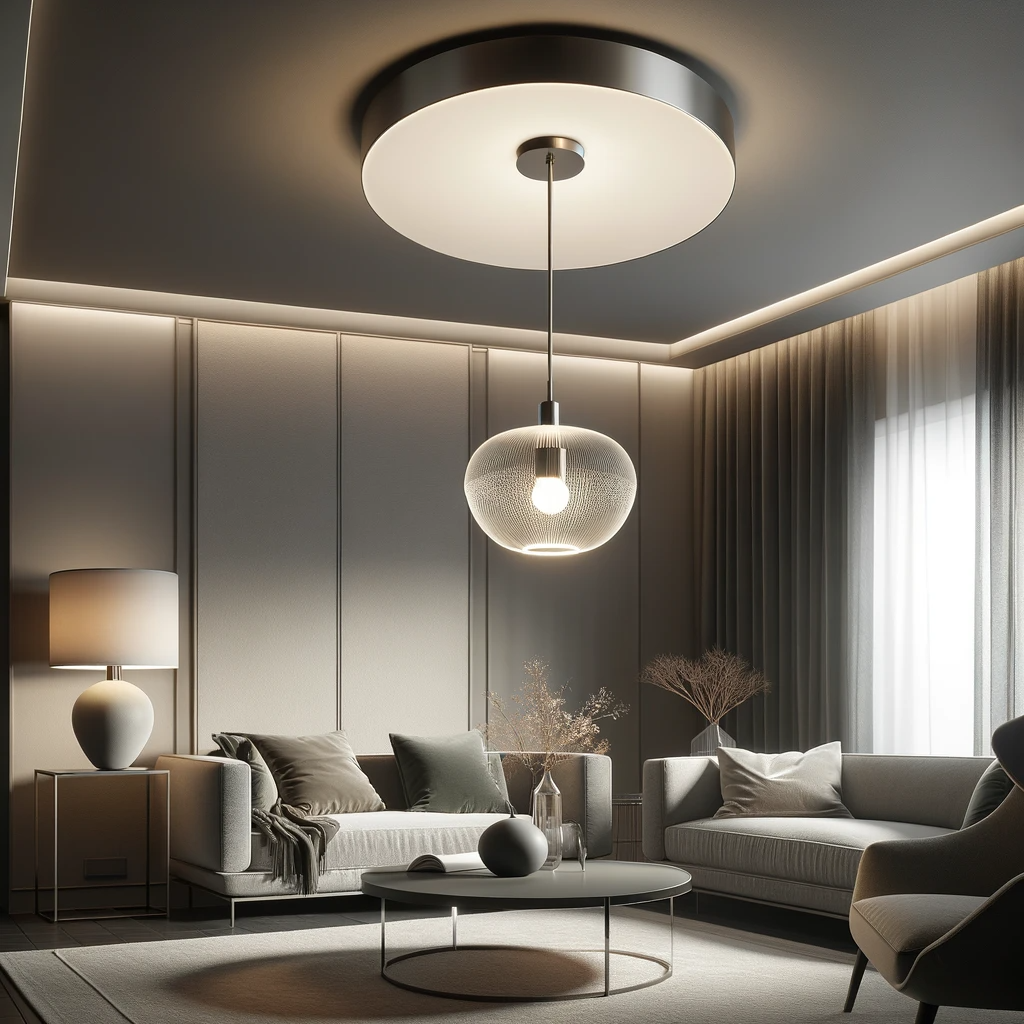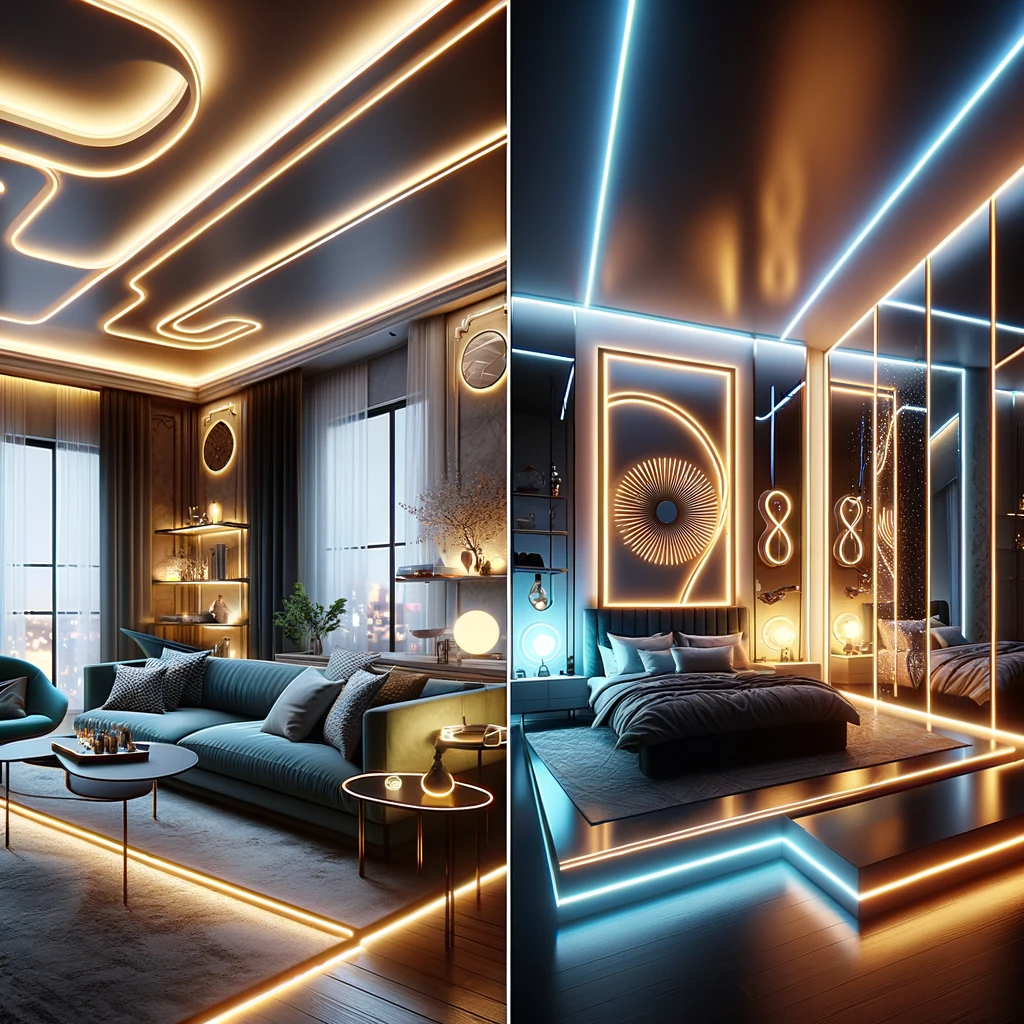What lighting to avoid seeing ceiling defects?
What lighting to avoid seeing ceiling defects?
The ceiling, often overlooked in interior design, plays a crucial role in the ambiance of a room. It reflects your style and attention to detail. Unfortunately, imperfections such as cracks, marks, or imperfect finishes are common and can mar your entire decor. Fortunately, there are innovative lighting solutions designed to camouflage these flaws while enhancing your ceiling. In this article, we explore a range of solutions, from discreet recessed spotlights to decorative LED lights, which not only mask imperfections but also transform your ceiling into an attractive design element. Learn how to choose the ideal lighting to highlight your ceiling and create a warm and welcoming atmosphere in your home.
Indirect lighting: The discreet ally
Indirect lighting, an often underestimated solution, proves to be a valuable ally in hiding ceiling imperfections. By using wall lights or adjustable LED spotlights, you create a soft, diffused light that spreads evenly throughout the room. This lighting technique has the advantage of minimizing imperfections by creating a delicate halo of light that envelops the ceiling, effectively concealing imperfections. This non-direct lighting is particularly suitable for rooms where you want to create a relaxing and welcoming atmosphere, such as the living room or bedroom. It also helps to visually enlarge the space, drawing the eye upwards and illuminating dark corners, for an enveloping and cocooning effect.

Pendants and ceiling lights: Divert attention with style
Pendant and ceiling lights, key elements of interior design, play a doubly beneficial role. Not only do they draw the eye and draw attention away from ceiling imperfections, but they also add a touch of sophistication to your space. Whether equipped with halogen or LED bulbs, these fixtures are available in a variety of styles, from contemporary designs to timeless classics. Opting for models with a dimmer switch allows you to adjust the light intensity according to your needs, creating a variety of ambiances, from an intimate dinner to a lively gathering. These lighting solutions are ideal for living spaces where aesthetics and functionality must harmoniously combine.
Diffused light ceiling lights: For even lighting
Diffused light ceiling lights are the epitome of subtlety and efficiency. Perfect for spaces where soft, enveloping lighting is desired, they use shades made of soft materials or frosted glass to diffuse an even, soothing light. These ceiling lights are particularly suitable for camouflaging ceiling imperfections while creating a warm and welcoming ambiance. They are an ideal choice for bedrooms and living rooms, where comfortable, glare-free lighting is essential for creating a space of relaxation and well-being.

LED strips: Modernity and subtlety
LED strips represent modernity and flexibility in lighting. Installed along walls or cornices, they provide discreet yet effective lighting that highlights the architectural lines of the room. These strips are perfect for creating accent lighting, highlighting the unique features of your space while masking ceiling imperfections. Their ability to play with colors and light intensities offers total customization, allowing you to change the ambiance of your room with a simple click.
Color Temperature: Choosing the Right Light
Color temperature plays a crucial role in the perception of your space. Warm light bulbs, such as warm white, create a cozy and welcoming atmosphere, softening ceiling imperfections. Conversely, white or cool lights tend to make these imperfections more visible. Using dimmable LED bulbs allows you to strike the perfect balance between aesthetics and functionality, giving you the freedom to adjust the ambiance according to the occasion or your mood.
A wide range of lighting options are available to mask ceiling imperfections, from discreet recessed spotlights to dynamic LED lighting. Feel free to experiment with different combinations and technologies to find the solution that best suits your space and needs. Good lighting doesn't just brighten a room; it transforms, beautifies, and creates the perfect atmosphere for every moment of your life.
FAQs
What is indirect lighting and how can it help hide ceiling defects?
Indirect lighting is a lighting technique in which light is directed toward walls or other surfaces before being reflected back into the room. It provides a soft, diffused light that minimizes ceiling imperfections. For this, you can use wall sconces or recessed spotlights directed toward the walls.
How can pendant lights distract from ceiling imperfections?
Pendant lights, such as chandeliers or designer pendants, draw the eye downward and create a focal point in the room. This helps draw attention away from imperfections in the ceiling.
What are the advantages of diffused light ceiling lights for camouflaging ceiling defects?
Diffused light ceiling lights diffuse light evenly throughout the room, creating a pleasant ambiance and reducing ceiling imperfections. For soft, even lighting, opt for ceiling lights with fabric or frosted glass shades.
How can LED strips help hide ceiling defects?
LED strips are a modern and aesthetic solution for illuminating ceilings while masking imperfections. They can be installed along walls or cornices to create indirect and subtle lighting. They also offer the ability to play with colors and light intensities, allowing you to customize the ambiance of the room.
How can the color temperature of light affect the perception of ceiling defects?
Light color can play a role in the perception of ceiling defects. LED bulbs with white or cool light tend to highlight imperfections, while warm or amber bulbs tone them down. Therefore, it's best to use warm light bulbs to create a cozy ambiance and hide ceiling defects.
What is a recessed spotlight?
A recessed spotlight is a type of light fixture that is installed inside an opening in the ceiling. It provides directional lighting and is often used to create indirect lighting.
What is an LED ceiling light?
An LED ceiling light is a type of light fixture that is mounted directly to the ceiling and uses light-emitting diodes (LEDs) as a light source. It provides uniform illumination and is energy efficient.
How to install recessed lights?
Installing recessed lighting typically involves drilling a hole in the ceiling at the desired location, inserting the light fixture into the opening, and then connecting it to the power supply. It is recommended to hire a professional electrician for this task.
What is an LED strip and how to use it?
An LED strip is a flexible strip of LEDs that can be glued to various surfaces to create indirect lighting. They can be installed along walls or cornices and offer the advantage of being able to play with colors and light intensities.
What is color temperature in lighting?
Color temperature refers to the color of light emitted by a light source. It is measured in degrees Kelvin (K). Lower color temperatures produce warmer light, while higher color temperatures produce cooler light.











Leave a comment